
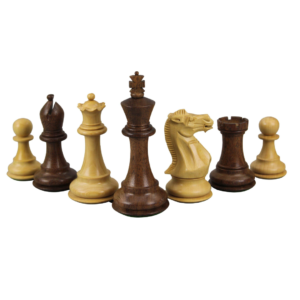







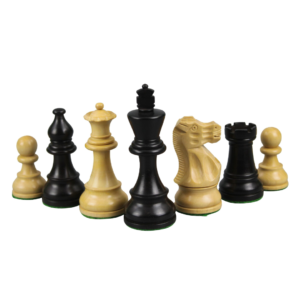

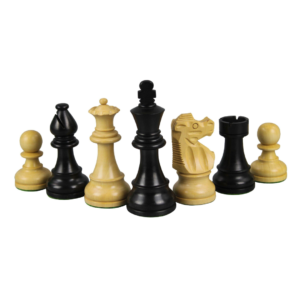

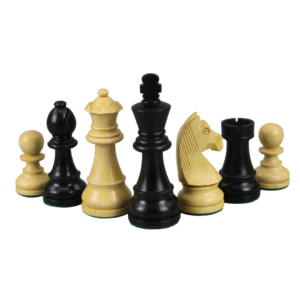
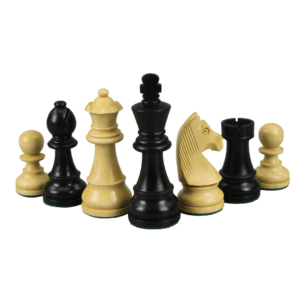

Chess, a game steeped in tradition and strategy, has evolved over centuries. One of the most recognisable aspects of the game today is the design of its pieces. The Staunton chess set, named after the English chess master Howard Staunton, has become the standard for chess pieces worldwide. Its iconic design, still in use at all major chess tournaments today, stands as a symbol of the game’s rich history and its enduring relevance. In this article, we will explore the history of Staunton chess pieces, their characteristics, manufacturing process, their weight and balance, and their role in tournament play.
Before the introduction of the Staunton chess set, chess pieces were often hand-crafted in a wide variety of styles, depending on regional preferences and individual makers. Pieces could range from overly ornate to highly simplistic, with many sets varying greatly in design. This lack of standardisation was problematic, especially as competitive chess tournaments began to gain popularity in the 19th century.
In the mid-1800s, the design of chess pieces underwent a significant transformation. The Staunton design emerged in 1849 when Howard Staunton, a prominent English chess player and one of the top players of the time, partnered with a London-based chess equipment manufacturer to create a new, uniform set of pieces. Staunton’s vision was to create a set of pieces that were not only aesthetically pleasing but also practical, with clearly distinguishable designs for each piece.
Staunton’s design was based on simplicity and elegance, with easily recognisable shapes that would make gameplay smoother. The set quickly gained popularity, and within a few years, it became the official design for major chess tournaments, solidifying its place in history.
Howard Staunton (1810-1874) was an influential figure in 19th-century chess. Aside from his work on chess pieces, he was a renowned player, author, and promoter of the game. He was instrumental in organising chess tournaments and establishing international chess rankings, which helped elevate chess to its modern status as a competitive sport.
Staunton’s involvement in the chess community went beyond just playing the game; he worked to standardise the chess set to make it more accessible and easier to use for players of all levels. His initiative to introduce the Staunton design was driven by the idea that chess pieces should be both functional and easy to distinguish, something that previous designs failed to achieve.
The design quickly gained widespread adoption, especially after Staunton’s endorsement of the set in the 1851 London International Chess Tournament, one of the first major chess events to use the set. From that point on, the Staunton chess pieces became the official standard in competitive play, a tradition that continues to this day.
The Staunton chess set is known for its distinct and easily recognisable features. Each piece has a unique shape that allows players to identify them quickly and accurately during a game.
The King is the tallest piece in the set, often around 3.5 to 4 inches (8.9 to 10.2 cm). Its design features a simple crown with a cross on top, representing the monarchy.
The Queen is slightly shorter than the King but is easily distinguished by its larger crown and a slightly more rounded top. It is often the most powerful piece in the game, symbolising its versatility.
The Rook, often referred to as a castle, is characterised by its turret-like shape. Its square base and distinct profile make it easily identifiable.
The Bishop has a pointed top with a cut through the middle, often referred to as the “mitre” or “cross.” This design reflects its religious connotations, with the piece traditionally symbolising the clergy.
The Knight stands out with its horse-shaped head, making it easily distinguishable. This piece is unique in that it moves in an L-shape, making it the only piece that can “jump” over others.
The Pawn is the smallest piece in the set, with a simple round top and a slightly larger base. Pawns often serve as the front line of defence in a game.
Traditionally, Staunton chess pieces were crafted from wood, with popular choices being boxwood, ebony, and rosewood. These materials were chosen for their durability and aesthetic qualities. However, as demand for Staunton sets grew, manufacturers began to experiment with different materials such as plastic, resin, and even marble for decorative sets.
Wood: The most common and traditional material for Staunton pieces is wood. Boxwood, a pale yellow wood, is often used for the lighter pieces, while ebony or rosewood, both darker woods, are used for the darker pieces. Hand-carved wooden pieces are highly sought after by collectors for their craftsmanship and authenticity.
Plastic: Plastic Staunton pieces are widely used for casual play and tournaments due to their cost-effectiveness and durability. These pieces are typically mass-produced using moulding techniques, which makes them accessible to a larger audience.
Resin: Resin is a popular material for luxury chess sets, as it can be moulded into intricate designs and can mimic the appearance of wood and other materials.
The process of creating Staunton chess pieces can be a meticulous one, especially for high-quality, hand-crafted sets. The production begins with the design, where the exact measurements of each piece are determined. For hand-carved pieces, the material is then shaped using chisels and knives, a process that can take several hours for each piece. The pieces are then smoothed, stained, and finished to achieve the desired appearance.
Mass-produced Staunton sets, often made of plastic or resin, are created using injection moulding, a process that allows for the production of large quantities of pieces at a much faster rate.
The quality of Staunton chess pieces varies based on the materials used and the craftsmanship involved. High-end sets, particularly those made from wood and hand-carved, are considered collector’s items and can command high prices. These sets often feature intricate details, smooth finishes, and precise dimensions. On the other hand, mass-produced plastic sets are more affordable and are designed for practical, everyday use.
Many Staunton chess pieces, especially those designed for tournament play, are weighted to provide a balanced feel. The weighting is typically achieved by adding small metal or lead discs to the base of each piece. This weight not only helps the pieces stay in place during play but also gives players better control when moving them.
The King and Queen are typically the heaviest pieces, with the Knight being slightly lighter due to its unique design. Pawns are the lightest pieces in the set.
The weight of the pieces affects their movement across the board. Heavier pieces are less likely to be accidentally knocked over during gameplay, making them ideal for high-stakes tournament environments. On the other hand, lighter pieces may be more suitable for casual players who prefer faster gameplay.
Staunton chess pieces became the official standard for tournament play due to their clarity and practicality. Their easily distinguishable shapes make it easy for players to quickly identify each piece, which is especially important in fast-paced games. Furthermore, their uniformity ensures fairness, as every player uses the same type of pieces.
The World Chess Federation (FIDE), the governing body for international chess competitions, has established specific guidelines for the dimensions and weight of Staunton pieces used in official tournaments. These guidelines ensure consistency across tournaments and help maintain the integrity of competitive play. For example, FIDE requires the King to be between 3.75 and 4.0 inches tall, with a base diameter of 40 to 50 millimetres.
While Staunton pieces are designed to meet the standards of tournament play, there are variations in size, material, and finish depending on their intended use. Tournament-quality sets are typically larger, heavier, and more durable, while casual sets may be smaller and lighter for convenience.
Some manufacturers offer custom-made Staunton sets, allowing players to choose the materials, colours, and finishes of their pieces. These luxury sets can be made from rare woods, high-quality plastics, or even metals, and are often crafted to reflect the buyer’s personal tastes.
Staunton chess pieces are highly collectible, particularly antique or hand-crafted sets. Many collectors seek vintage sets made by renowned manufacturers such as Jaques of London, the original producer of the Staunton design. When collecting, factors such as the material, craftsmanship, age, and rarity of the pieces play an important role in determining their value.
Staunton chess pieces have appeared in numerous movies, TV shows, and books, often serving as a symbol of intellectual prowess. Most notably, they are featured in the popular Netflix series “The Queen’s Gambit,” where the pieces take on a central role in the storyline.
The Staunton chess set, designed in the mid-1800s by Howard Staunton, has become the undisputed standard in the world of chess. Its distinct and functional design has not only facilitated competitive play but also made the game more accessible to players of all levels. Whether in tournaments or casual settings, Staunton chess pieces remain a symbol of the game’s rich history and enduring appeal. From their manufacturing process to their role in major competitions, these pieces continue to shape the way chess is played and enjoyed worldwide.
We pride ourselves on offering personalized service to every customer. Whether you need advice on choosing a product or have a specific request, our team is here to help.